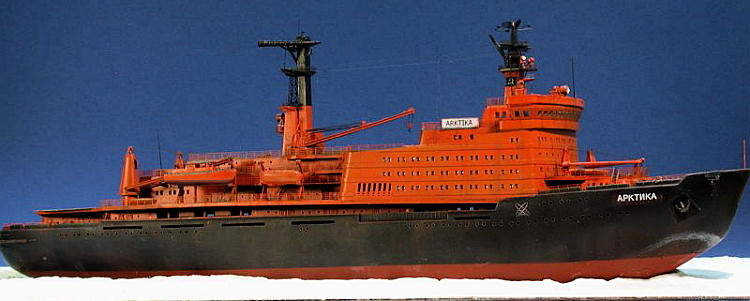
| KIT #: | ? |
| PRICE: | $ |
| DECALS: | None |
| REVIEWER: | Frank Spahr |
| NOTES: |

| HISTORY |
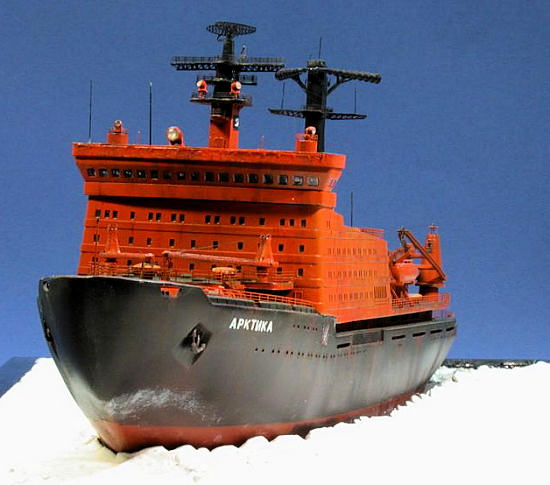
Length:
148 m
Width:
30 m
Draught:
11 m
Height from keel to masttop:
55 m
Displacement:
23.000 t
Powerplant:
2 OKA-900A Reactors @ 171 MW, 75.000
hp on three shafts
Crew:
appr. 150, appr. 100 passengers
The vessels have a double hull, made
from steel of up to 48 mm (about 1.75 in) thickness. Water ballast may be
trimmed between the hull shells to ease icebreaking. A water jet system further
enhances icebreaking capabilities. The vessels can break ice moving ahead as
well as astern. As they have no reactor cooling system, they may only be used in
cold waters – hence they can´t be relocated from the Arctic through the Tropics.
Typically, only one reactor is used at any given time, leaving the other as
reserve power plant. The vessels are designed and equipped to stay at sea for
seven and a half months, the duration of a typical winter season. Nuclear
refueling will be necessary every four
years. The vessels have one or two helicopters plus various boats,
amongst them up to four inflatable boats. To improve crew comfort during the
long deployments, they are equipped with swimming pool, sauna, cinema and a gym.
The ship´s restaurant also has a bar. Some vessels have a library and at least
one has a volley ball court. The latest vessel, „50 Let Pobedy“ („50 years
victory“) is markedly different from earlier units; her hull is longer and the
hull form has been improved.
Arktika was commissioned in 1975 as lead ship of the class. On 17 August, 1977, she reached the North Pole as the first surface vessel. In the late 1990ies she was modernized, reaching an impressive 1,000,000 nautical miles after 30 years of service in 2005. A fire on board in 2007 led to her eventual decommissioning in 2008. She is slated to be scrapped.
| THE KIT |
Alanger reissued Maquette´s ancient
kit of the Arktika in 2007. Since then, the company failed, but kits are
available here and there (I know of one gathering dust in my LHS). The roomy and
strong box contains three sprues of medium grey styrene, with hardly any flash –
at least in my case. Everything looks very sturdy, and the hull looks capable of
breaking the layer of ice to by found in your average whisky on the rocks. Upon
measuring hull length, it is to scale. I did not take any further measurements.
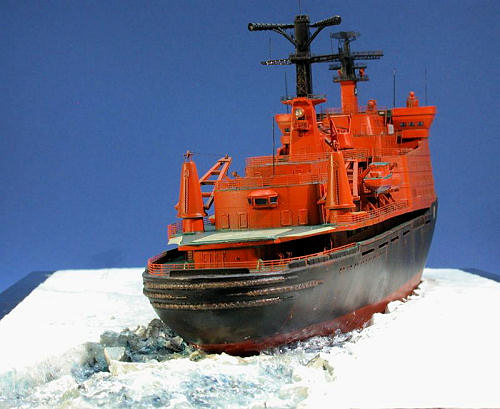 Portholes
are cleanly molded, but there are no hawseholes. The icebreaker bow is nicely
rendered, but there are no more hull details. The vessel´s name and nuclear
insignia are rendered in raised detail. Sprue attachment points are rather
strong and crude. The decks have rather crude raised details and molded on
anchor chains, the helipad is rendered in raised detail, too. Some parts are
molded really nicely detailed (such as the launch), others are really crude,
like the almost unrecognizable helicopter, the inclined
ladders and the lattice masts. Given the age of the molds, this is
virtually inevitable. Most of the numerous windows are nicely shaped, only the
bridge windows (of all things!) are anything but rectangular. Ejector pin marks
can be found in numerous and sometimes pretty nasty places.
Portholes
are cleanly molded, but there are no hawseholes. The icebreaker bow is nicely
rendered, but there are no more hull details. The vessel´s name and nuclear
insignia are rendered in raised detail. Sprue attachment points are rather
strong and crude. The decks have rather crude raised details and molded on
anchor chains, the helipad is rendered in raised detail, too. Some parts are
molded really nicely detailed (such as the launch), others are really crude,
like the almost unrecognizable helicopter, the inclined
ladders and the lattice masts. Given the age of the molds, this is
virtually inevitable. Most of the numerous windows are nicely shaped, only the
bridge windows (of all things!) are anything but rectangular. Ejector pin marks
can be found in numerous and sometimes pretty nasty places.
The watertight doors are provided as individual parts. This is helpful as it saves the modeler the effort of sanding the crude parts off. Luckily some faint marks on the bulkheads give an idea of where to place the PE parts, as the very poor instruction sheet isn´t particularly helpful. The weakest point of the kit, this instruction sheet is light years behind other Russian manufacturers´ offerings. The painting guide is especially poor and doesn´t offer any manufacturer info, just basic colours. Whereas the Arktikas formerly had buff or ochre superstructures, more recent images show brighter orange shades. One of the later vessels, „Jamal“, moreover sports what must be the world´s largest sharkmouth around her bow. As in anything regarding this kit, the modeler needs to research and devise their own solutions for the paint issue. I know of no specific PE sets, and with the kit OOP the chances are really slim that any manufacturer will embark on such a project. Alanger has not added the decals of the old Maquette kit, but then all the markings are provided in raised detail already ...
| CONSTRUCTION |
Several things were clear from the
outset – I would present Arktika in a diorama setting, plowing through the ice,
and I wanted to spruce the dated, yet still attractive kit up a bit. So I looked
for convenient PE set and came up with
-
my PE spares box, which is a folder
with numerous sheet protectors
-
Lion Roar´s 1:700 set of Soviet
Radars
-
Saemann´s 1:350-400 four bar railing
(I needed two full sets, equaling a full six feet of railings!)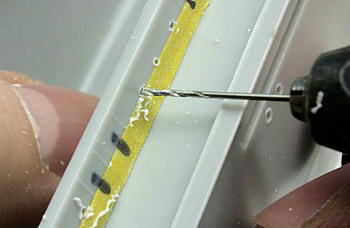
-
GMM´s 1:700 set for Japanese Cruisers
and Destroyers
I started with assembling the hull,
filling and sanding where needed. The hawseholes were opened and the portholes
redrilled. As far as possible, the superstructure was prefabricated in
subassemblies. This necessitated grinding the massive bulwarks away, redrilling
the portholes, and a lot of filling and sanding. To get the portholes in
alignment, Tamiya tape was used as a guide. The bridge windows were carefully
cleaned up using needle files. On the deck, the massive molded on anchor chains
were removed.

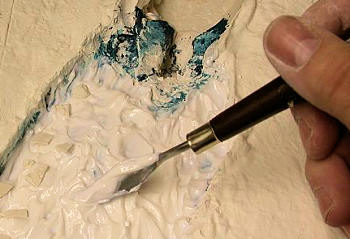 ade
from plaster. These days, I would rely solely on foam board, last year I wasn´t
that far. The vessel was kept removable for the time being. The ice surface was
painted with „polar white“ wall paint, obviously nothing else would do. The
disturbed water behind the vessel was crafted from acrylic gel, pieces of
plaster and some effective painting. The clear acrylic gel adds some depth to
the sea. After completing the vessel, she was glued into place using acrylic
gel.
ade
from plaster. These days, I would rely solely on foam board, last year I wasn´t
that far. The vessel was kept removable for the time being. The ice surface was
painted with „polar white“ wall paint, obviously nothing else would do. The
disturbed water behind the vessel was crafted from acrylic gel, pieces of
plaster and some effective painting. The clear acrylic gel adds some depth to
the sea. After completing the vessel, she was glued into place using acrylic
gel.
| MORE CONSTRUCTION |
Before I could do that, I needed to
actually build the vessel. All in all, there were no major fit issues save the
bridge where it is glued to the hull. Not knowing how to correct that, I decided
to leave things as they were – also leaving a skeleton in my closet when
watching the vessel from certain
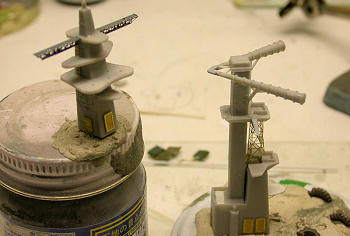 angles.
After the serious sawing and grinding and filling I had done, now was the time
to add detail to the pretty crude-looking hulking beast of a ship. If you see
crew figures, you´ll realize that the Arktikas are really massive vessels.
angles.
After the serious sawing and grinding and filling I had done, now was the time
to add detail to the pretty crude-looking hulking beast of a ship. If you see
crew figures, you´ll realize that the Arktikas are really massive vessels.
Working after what images I had found
and those that were provided by my modeling friend Lars Scharff (thanks, Lars!)
I replaced the watertight doors with some of the numerous leftovers from WEM´s
HMS Hood set. The kit instruction from hell was oftentimes pored over with
deeply furrowed brows, especially where it came to construction and plac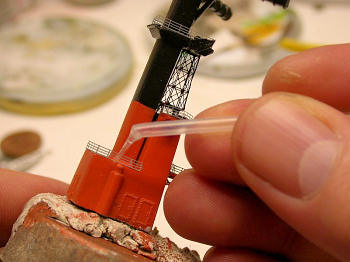 ement
of subassemblies. The two masts with all their platforms and antennas were
especially demanding in that respect – they are small kits in their own rights.
I ended up using parts for Japanese aircraft catapults, searchlight towers,
scrap PE, wire and stock styrene. The very fiddly radar arrays were cobbled
together from the abovementioned Lion Roar set. The cranes were detailed using
scrap PE, such as pieces of 1:350 railing and also the very useful
Scheuer&Strüver 1:250 set with hooks, pulleys and other detail parts. Numerous
inclined ladders by Saemann were used, along with the large amounts of railings.
The ship´s boats were detailed a bit, too, in that way. The bridge roof received
a more to scale bulwark from CA-infused paper with some scrap PE.
ement
of subassemblies. The two masts with all their platforms and antennas were
especially demanding in that respect – they are small kits in their own rights.
I ended up using parts for Japanese aircraft catapults, searchlight towers,
scrap PE, wire and stock styrene. The very fiddly radar arrays were cobbled
together from the abovementioned Lion Roar set. The cranes were detailed using
scrap PE, such as pieces of 1:350 railing and also the very useful
Scheuer&Strüver 1:250 set with hooks, pulleys and other detail parts. Numerous
inclined ladders by Saemann were used, along with the large amounts of railings.
The ship´s boats were detailed a bit, too, in that way. The bridge roof received
a more to scale bulwark from CA-infused paper with some scrap PE.
| COLORS & MARKINGS |
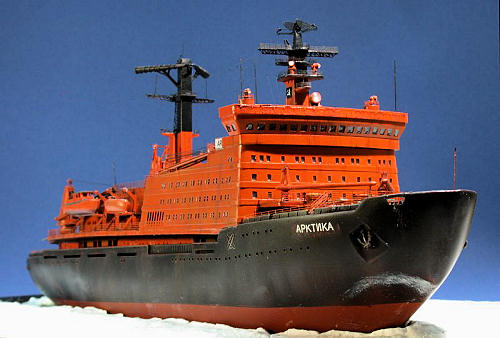
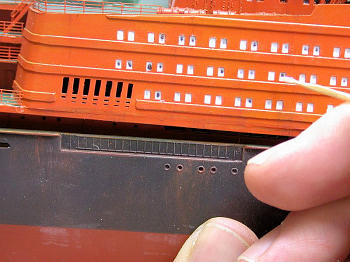 superstructure
was designed using graphics software, printed out and glued to sheet styrene.
The vessel was rigged using black stretched sprue. An uneven clear satin coat
blended things in and hid most glue spots and other embarrassing things. The
open windows were filled with white glue, the simplest glazing money can buy in
my book. A few Preiser figures were placed around the bridge.
superstructure
was designed using graphics software, printed out and glued to sheet styrene.
The vessel was rigged using black stretched sprue. An uneven clear satin coat
blended things in and hid most glue spots and other embarrassing things. The
open windows were filled with white glue, the simplest glazing money can buy in
my book. A few Preiser figures were placed around the bridge.
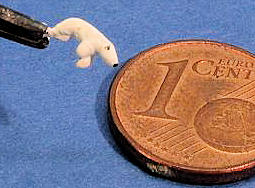
| CONCLUSIONS |
This turned out to be much more fun than originally expected upon receiving the kit. I particularly enjoyed finding solutions without having prefabricated parts, and I really like the stark shape of the vessel breaking the ice. Anyone may decide how far they modify the original kit, it´s going to be fun anyway!
| REFERENCES |
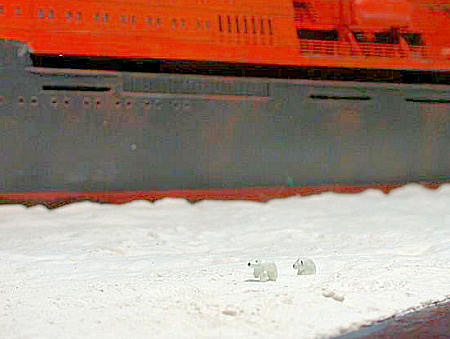 http://en.wikipedia.org/wiki/Arktika
http://en.wikipedia.org/wiki/Arktika
http://mkmagazin.almanacwhf.ru/ships/arktika.htm
http://www.barentsobserver.com/index.php?id=4514785
September 2009
If you would like your product reviewed fairly and quickly, please contact me or see other details in the Note to Contributors.